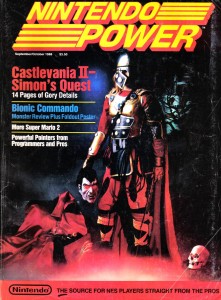Lost Classics: Nintendo Power (Gaming Magazine)
by William Talley, filed in Lost Classics, Powet Game News on Sep.26, 2012

This past month, Nintendo Power announced that it would not be continuing its groundbreaking gaming magazine, Nintendo Power. The magazine, which has been in print for 24 years, will end with its December 2012 issue. For many gamers, myself included, this will be the end of an era. Although I had stopped reading it long ago , I remember it as one of the best gaming magazines ever created. I had a subscription since 5th grade and kept reading it all the way through the middle of my sophomore year in high school when I got my Playstation. Every month in between, I remember eagerly waiting beside my mailbox for my book to come through. The extras were awesome as well. When my mother first bought me a subscription, it came with 4 free guides: A book about Game Boy, A book about the then-upcoming SNES, Mario Mania (A game about all things Mario) and the NES Atlas (A guide with the maps of all the levels in games such as Ninja Gaiden and Mega Man). Even today, it remains the gold standard in printed gaming journalism, even if it’s obviously biased towards Nintendo.
Nintendo Power first began life as the Nintendo Fun Club. It was a free publication which focused on Nintendo games. After 7 issues, it was discontinued, and Nintendo Power took its place. While the NFC focused only on Nintendo-published games, Nintendo Power focused on third-party games from developers such as Capcom and Konami. While other magazines feature reviews, previews, and a secret code section, Nintendo Power featured in depth coverage on various games, featuring entire maps, and mini-strategy guides on the games. Many of the issues also featured comics based on games. The SNES releases of Super Mario World, Super Metroid, and A Link to the Past were accompanied by monthly serials based on the games. Other comics were based on Star Fox, Star Wars: Shadows of the Empire, and Kirby. The most well known star of Nintendo Power’s comics was of course, Nester, a smart mouthed young lad. Each month, him and his buddy Howard (based on editor Howard Phillips) would explore the worlds of various Nintendo Video games. Nester himself would show up in a few Nintendo games, first as a commentator in NFL Play Action football, then with a cameo in the shooter To The Earth, and finally as the main character in the Virtual Boy title Nester’s Funky Bowling. If there was a character long overdue for an appearance in the Smash Bros franchise, it’s him. The magazine also attracted some controversy in its second issue, which featured Castlevania’s Simon Belmont holding Dracula’s decapitated head as a cover image. Parents reported that the image gave their kids nightmares.
Nintendo Power also featured some pretty cool extras. When Dragon Warrior (the U.S version of Dragon Quest) failed to move units the way it did in Japan, the game was given free to new subscribers during the early 90s. Other promos included free strategy Guides, trading cards, and strategy guides, back when they were unique enough for people to care about them. Other mags tried to follow the blueprint that Nintendo established, particularly, Sega’s Sega Visions magazine, a book about all things Sega. However, few of them would last as long as Nintendo Power.
When Nintendo Power ships its final issue, a small piece of gaming history will be gone with it. It joins magazines such as GamePro, DieHard Game Fan, and Game Players as lost memories and relics of our hobby. There had never been a magazine like Nintendo Power before, nor will there ever be one after.


 PS3
PS3
 Famicom Dojo
Famicom Dojo KEEP PLAYING
KEEP PLAYING KEEP PLAYING: Rewind
KEEP PLAYING: Rewind Powet Toys
Powet Toys Powetcast
Powetcast Hitchhiker's Guide POWETcast
Hitchhiker's Guide POWETcast














